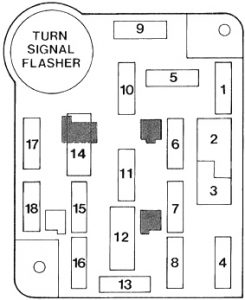Ford F250 (1987 – 1991) – fuse box diagram
Year of production: 1987, 1988, 1989, 1990, 1991
Fuse box

| No. | A | Circuits |
| 1 | 15 | Stoplights, Hazard Lights, Speed Control |
| 2 | 7 | Circuit Breaker: Windshield Wiper Motor |
| 3 | — | — |
| 4 | 15 | Main Light Switch, Exterior Lights, Instrument Panel Illumination |
| 5 | 15 | Turn Signals, Back-Up Lights, Overdrive Transmission, Roof Map Light |
| 6 | 15 | Speed Control, Accessories & 4WD, Auxiliary Battery Control, Digital Clock, Rear Window Defogger, Feedback Carburetor Control (4.9L), Windshield Wiper Switch, Electronic Shift Control Module, Rear Anti-Lock Brakes |
| 7 | — | — |
| 8 | 15 | Courtesy Lights, Dome Lights, Cargo Light, Glove Box Light, Warning Buzzer, Radio |
| 9 | 30 | Heater or A/C-Heater |
| 10 | 5 | Instrument Illumination (Radio, Instrument Cluster, Wiper and Washer Switch, Overdrive Switch, 4WD Shift Control Switch, A/C-Heater Control, Rear Window Defogger, Ashtray, Cigarette Lighter), Main Light Switch, Clock Dimming, Radio Display Dimming |
| 20 | Rear Anti-Lock Brakes | |
| 11 | 15 | Radio & Clock Illumination, Headlight Switch Illumination |
| 10 | Radio | |
| 12 | 30 | Circuit Breaker: Power Door Locks |
| 25 | Transfer Case Control | |
| 25 | Tailgate Power Window, Power Mirrors | |
| 13 | 5 | Instrument Panel Illumination |
| 14 | 30 | Circuit Breaker: Power Windows |
| 25 | Tailgate Power Window | |
| 15 | 10 | Auxiliary Fuel Tank, Switch |
| 16 | 30 | Horn Relay (with Cruise Control), Horn Relay Jumper (without Cruise Control), Cigarette Lighter, Speed Control, Ashtray Illumination |
| 20 | Horn, Cigarette Lighter | |
| 10 | Horn | |
| 17 | 5 | Instrument Illumination, Clock & Radio Display Dimming |
| 20 | Rear Anti-Lock Brakes | |
| 18 | 15 | Cluster, Safety Belt Buzzer, Warning Indicators, Tachometer, Diesel Glow Plug Control (6.9L, 7.3L), Diesel Indicators (6.9L, 7.3L), Electronic Engine Control (EEC), Carburetor Circuits, Choke Heater, Electric Fuel Pump Control (7.5L), Dual Brake Warning Diode-Resistor, Low Vacuum Warning Switch (6.9L, 7.3L) |
WARNING: Terminal and harness assignments for individual connectors will vary depending on vehicle equipment level, model, and market.
